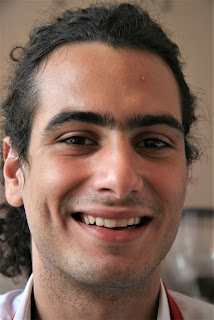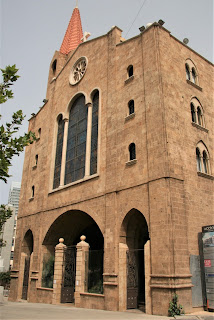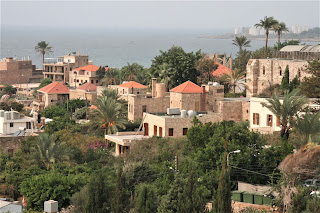A glimpse of diverse Lebanon in 2010
(Travel Story Series @ Hon Too Fang 2021)
Preface
My wife and I joined a 14-day semi back-pack tour to Syria and Lebanon in late September 2010. This is my account of the tour in Lebanon, just a glimpse of it.
Part A – General
A 1 – Lebanon the country
Lebanon is a country in the Middle East west of Syria and east of the Mediterranean Sea. The area is 10,500 sq km (about 50% of our Perak state) with a population of 5.0 million. It has a long history, ruled by all kinds of foreign empires over the centuries. One notable civilisation that emerged from Lebanon is the Phoenician, from 1100 BC to 200 BC. Their legacy is the Phoenician alphabets from which the Greek and Latin alphabets are derived.
After WW1, they became a French colony and declared their independence in 1943 amid WW2. Lebanon's history since independence has been marked by alternating periods of political stability and prosperity interspersed with political turmoil and armed conflict.
Lebanon is a parliamentary democracy, based on the sharing of power among the religious groups, a term called confessionalism. The many top posts in the government have been assigned to a specific group of people. For example, the President must be a Maronite Christian, the Prime Minister a Sunni Muslim and the Speaker of Parliament a Shia Muslim etc. This system is intended to deter sectarian conflict and to represent fairly the demographic distribution of the 18 recognized religious groups in government.
Despite the share of political power, sectarian conflicts do continue. The conflict of Israel and the Palestine’s PLO in the 1970s, later joined by the Syrians, spilled over into southern Lebanon. The civil war lasted some 16 years from 1974 to 1990, with over 200,000 deaths. Sporadic conflicts and political assassinations continued until the 2000s. Peace only restored after Israel fully withdrew in 2000, and Syria in 2005.
In terms of economy, the service sector (mainly tourism and banking) contribute 65% of the GDP, followed by manufacturing at 20%. Remittance from Lebanese living abroad contributes significantly to the well-being of the economy.
Lebanon is one country without a population census since 1932, due to the sensitive confessional political balance between Lebanon's various religious groups. The estimate is there are some 60% Muslims and 40% Christians. The Muslims are made up of equal proportions of Sunnis and Shias. For the Christians, the biggest group is Maronite Catholic, followed by Greek Orthodox.
(Note in 2021: Lebanon is also seriously affected by the current Civil War in Syria. There is an estimated 1.5 million Syrian refugees in Lebanon. They are mostly Sunni Muslims and this has caused a kind of crisis in the political stability of Lebanon since their government is based on a pre-set form of power sharing. Now the Sunni Muslim outnumber everybody and demands more power)
A 2 - First lesson in Lebanon
Lebanon is a war-torn country. The first words our local tour guide taught us in Lebanon is to say the following in Arabic, "Please don't shoot. We are tourists!" Believable? Of course not. That was a joke played by the tour guide. No more applicable in 2010. There were no civil wars in 10 years and no more large scale unrest in 5 years. You think somebody so "kia-si" like me would risk my life there? Lebanon, except the southern region, is relatively peaceful the last 10 years or so.
Victims of last civil war: an old office building and the bullet-riddled, arm-broken statues at the Martyrs' Square in Beirut.

A 3 - Beirut is a "eeeek" city
The capital of Lebanon is Beirut, a very modern city. Many new cars and they speed like hell. At every corner they don't slow down much creating all the "eeeek, eeeek" sound. Everywhere. On our way to the airport the taxi was speeding at about 120 km/h on a 6-lane highway. Not the access-controlled highway like our North-South Highway, but access-allowed highway like Jalan Universiti in PJ. I was seated beside the driver and dared not look at the speedometer.
A 4 - Faces of Lebanon
The Lebanese, regardless of the region or religion sect, are predominantly native Levantine rather than Arab ancestrally. Levantines are people from Eastern Mediterranean. So they look more like Greeks. But the language used is Arabic. The last one is a happy tourist from Nigeria. The 2nd last a statue of a patriarch of the Armenian Catholic Church in Lebanon
A 5 - Fellow tourists
One morning the two of us went "lepak" at the Esplanade in Beirut for more than an hour. We saw several busloads of Iranian tourists there, mostly older people. They were all very friendly. My wife was invited to be seated among them for group photos. Not once but 3 times. May be they have not seen yellow-skinned people before. And the Iranian ladies just cover their head with the simple "tudong" or scarves. Nobody covered her face.
Part B - What to see in Lebanon?
We went to 4 places.
B 1 - Beirut - the capital
Beirut has a history of over 5,000 years. It is the capital, main sea port and biggest city in Lebanon, population estimated at between 0.9 to 1.2 million. Religion wise the ratio of Muslims and Christian is about 40:60. It is a regional financial centre and tourist city. Shown street scenes. A lot of construction activities, meaning economy is good.
The Esplanade
The Corniche Beirut is a seaside promenade 4.8 km long lined with palm trees. A venue for walks and jogs and bikes with views of the Mediterranean. Shown the iconic Pigeon Rocks.
Roman ruins
Within the city centre, there are many pockets of preserved ruins, like the columns of the Roman Basilica near the Forum of Berytus and the Roman Bath of Berytus.
Miscellaneous
Night scene of the 1930 clock tower at the Nejmeh Square with its 4-faced Rolex clock, and a commercial building nearby. The Neimeh Square is the focal point for tourists. Then the Martyrs' statues, the iconic bullet-riddled centrepiece at the Martyrs Square in memory of the Lebanese who revolted against the Ottoman Turks and were executed here in 1916, and a bride on photo shoot. The Martyrs’ Square is the focal point for political activities.
B 2 – Religious buildings in Beirut
The City Centre is one of the most religiously diverse areas in the world. Mosques and churches stand side by side on the streets. Several of these churches and mosques are hundreds of years old and are of high archaeological significance. In total, it is home to 10 churches, 6 mosques, and one synagogue. Despite the severe destruction incurred on these buildings during the Civil War they have been restored to their prior shape and are all currently in use.
Saint George Maronite Cathedral
The Maronite is a Catholic group originated from Lebanon founded by a Syriac hermit monk Maron in the 4th century. It is the largest Christian sect in Lebanon and part of the Eastern Catholics. The cathedral was built between 1884 and 1894 replacing an old one built in 1753.
Cathedral of Saint Elias and Saint Gregory the Illuminator
This is an Armenian Catholic church. St Gregory the Illuminator was a late 3rd century saint who is the patron saint of Armenia and founder of the Armenian church. This church was completed in 1959, replacing an old one built in 1860. Saint Elias is Saint Elijah, the more common name for the Old Testament prophet.
Saint Louis Cathedral
This is a Roman Catholic cathedral built by the Capuchin missionaries in 1864 with French fund and named after King Louis IX of France. Its striking sandstone façade and high arched ceiling with elaborate stonework make it one of the most beautiful structures in Beirut. We tried to attend a mass here but missed that because of misreading the schedule in French.
St Elias (Elijah) Maronite Church
This Maronite Catholic church was built in 1907. There was a baptism service going on when we visited the church. The parents and grand-parents came in evening gowns and suits, meaning they treat the occasion very solemnly. There was a crew taking video too.
Two Orthodox churches
The 1st photo shows the façade of the Saint George Greek Orthodox Cathedral built in 1772 and the other 3 photo the Saint Nichan Armenian Orthodox Cathedral, constructed in 1907 in typical Armenian architecture. Visitors are not allowed into these Orthodox churches, so there are no interior shots. The last 2 photos were taken outside the church proper.
Mohammad Al-Amin Mosque
This is a new Sunni Muslim mosque completed in 2008, the biggest mosque in Lebanon. It has multiple domes and the main one is 48 m high. The minarets are 65 m high. The domes are of light blue colour with the use of blue tiles. The design follows Ottoman’s monumental architecture.
Two other mosques
Shown facades of the Emir Assaf Mosque, built in 1597, and the Emir Munzer Mosque built in 1633, both during the Ottoman era. We did not go inside.
B 3 – Maalbek – a huge old ruin
Maalbek is a town about 65 km north-east of Beirut, with a population of some 83,000. It is home to a huge temple complex dated to Greek and Roman times, a UNESCO World Heritage site. A huge complex, gigantic columns, tall monuments, vast squares. When the Muslims took over this place in the 7th century they turned it into a fortress with further reinforcement. It was abandoned in the 14th century. Subsequent earthquakes and weathering and pilferate turned it into a ruin.
The 1st 2 photos show the entrance portico on the west side. Only 7 of the 12 columns remain. The 3rd shows shops in the hexagonal court probably used as a public forum, and lastly the defence perimeter walls added by the Muslims.
The 1st 2 photos show the general view of the Great Court, about 130 m by 115 m. The platform near the top left in the 1st photo is the huge altar for burnt offering. The other 2 show the remains of more porticos and walls of the Temple of Jupitar. Some of the columns are granite, black in colour, imported from Aswan in Egypt, about 1,100 km away (straight line distance). Simply incredible feat.
The Temple of Jupiter, dedicated to the chief Roman god, was completed around 60 AD. It is 88 m long and 44 m wide. There were 54 columns forming a peristyle surrounding the temple, each almost 20 m in height, now only 6 remain. 8 of them were taken to build the Hagia Sophia in Istanbul in the 6th century, about 1,000 km away (on a straight line). The columns support massive lintel beams decorated with bas-reliefs like the fallen ones in the 2nd and 3rd photos. The temple was the largest Roman temple ever built.
(Note in 2021: The temple was built on top of a 6 m high platform made up with 24 gigantic pieces of rock, in layers. The largest 3 pieces are about 19 m long, 4.3 m by 3.6 m in section, each weighing over 800 tonnes. The quarry is about 1 km away. The huge standing columns are dwarfs compared to these flat members. There are 2 more such huge ones at the quarry, which we didn’t visit, one of them as shown. Photo taken from the internet)
The other main temple is the Temple of Bacchus, dedicated to the Roman God of Wine. It is 66 m by 35 m and 31 m high, completed in the late 2nd century AD, the largest standing and best-preserved Roman temple in the world. The richly carved ornamentation on the columns and entablatures are particularly awe-inspiring.
Take note of the size of the people in the 1st photo to realise the size of the temple. The last 2 photos show the decorative parts, finely carved some 2,000 years old.
B 4 – Byblos – ruins of different eras
It is a town on the coast of the Mediterranean Sea about 45 km north of Beirut, with a population of 40,000. The town has a history of being continuously inhabited for over at least 7,000 years and is a UNESCO World Heritage site. We visited the archaeological site and the neighbourhood.
The ruins
The 1st 2 photos show the general view of the site taken from the upper level of the Crusaders Castle. The ruins in the foreground of the 1st photo are Phoenician dwellings and old walls older than 3,200 years. Then remains of Roman columns and the Roman theatre, re-constructed on a smaller scale using the original stones.
The 1st 2 photos show the Crusader Castle built in the 12th century, some exhibits in the small museum inside the castle, and a sarcophagus in an underground chamber (down by a narrow shaft) dated to the Egyptian times or some 4,000 years ago.
The town
It is a touristic town, often being voted as the best Arab town/city to visit, and said to be the favourite Mediterranean town for Marlon Brando and Frank Sinatra in the 1960s and 1970s. We had a brief stroll at the historic quarter near to the ruins, lined with cafes and souvenir shops. The last 2 photos show the Cathedral of Saint John-Marc rebuilt in 1776. The clock tower is dated to the Crusader church built in the 12th century.
B 5 - Jeita Grotto – a limestone cave
This is a nature's wonder high up on a mountain reachable by cable cars, 18 km north of Beirut. There are 2 separate but inter-connected series of karstic limestone caves. Upper Cave is a walking tour, Lower Cave boating tour. First time for us having a boat/walk cave tour. The sculpture "Guardian of Time" is found at the exit of the Lower Cave. A group photo with tourists from Nigeria. Photography is prohibited inside the caves, the last photo showing the cave scene is taken from the site’s official website.
B 6 – Masnaa – an unusual border crossing
We crossed from Syria into Lebanon via the Masnaa Border Crossing. It is in fact the main crossing between the 2 countries. Since Syria and Lebanon are long time adversaries rather than friends, there is an 8 km buffer zone between the check points.
The access is a 2-lane road. And on the buffer zone or no man’s land are numerous tents for the nation-less, criminals, drug traffickers, human traffickers, and Gypsies, according to our guide, Mr Muhraf. Shown the road and the tents. Of course this is not a tourist spot, but we certainly have not seen such kind of buffer zone before and so I included it here.
Part C - Some general observation on Lebanon
C 1 – country of assassins
Lebanon is not that stable politically. Over the last 20 years, there is a long list of senior politicians being assassinated. The victims include a former president, a former prime minister, a minister, 4 members of parliament, 4 heads/high level political party leaders, 3 commanders of army/militia, the Sunni Grand Mufti, and several political researchers and activists. The most high profile case is the assassination of the former prime minister Rafic Hariri in 2005. He and 21 others were killed by a powerful car bomb. He was Prime Minister for 1992-1998 and 2000-2004. He was a Sunni Muslim and the assassins were from Shia-supported Hezbollah. We visited his memorial at the Martyrs’ Square. Also shown some boisterous youth in some political gathering on the street in Beirut.
(Note in 2021: the current prime minister, since 2016, is Saad Hariri, son of Rafic)
C 2 - They worship side by side
Lebanon has about 60% Muslims and 40% Christians. But in the capital, Beirut, it is the reverse. Christians outnumber Muslims by 60/40. But they worship their gods side by side. Within the old city centre there are at least 10 churches of various denominations and 6 mosques. The biggest mosque is the beautiful Mohammad Al-Amin Mosque and the most important church is the Maronite Catholic Cathedral of St George, as the Maronite is the biggest Christian group. And these two stand side by side. No problem. See the photo below.
In Malaysia it is insensitive to the Muslims' feeling if your church is built within several km of the mosque. Malaysia Mana Boleh?
C 3 - the non-Roman Catholic
I am a born Roman Catholic. I often call myself a Catholic, not using the "prefix" Roman assuming all Catholics are Roman Catholics. After coming to Syria/Lebanon I realised that there are 30 more Catholic groups in the World: Syriac Catholics, Milkite Greek Catholics, Chaldean Catholics, Maronite Catholics, Armenian Catholics, etc. Paul the half-baked Catholic Mana Boleh? These are generally grouped as Eastern Catholics. They are called Catholics because they are in full communion with the Roman Catholics headed by the Pope and respect the Pope as the “First among Equals”.
C 4 - The YonGo special
The tour is organised by YonGo (http://www.yongo.biz/), with 16 members.
C 5 - Photo of the Tour
A night shot of the beautiful Mohammad Al-Amin Mosque in Beirut
That’s all folks.
(First written in the email format in October 2010. Heavily revised to this PDF format in July 2021)































































































